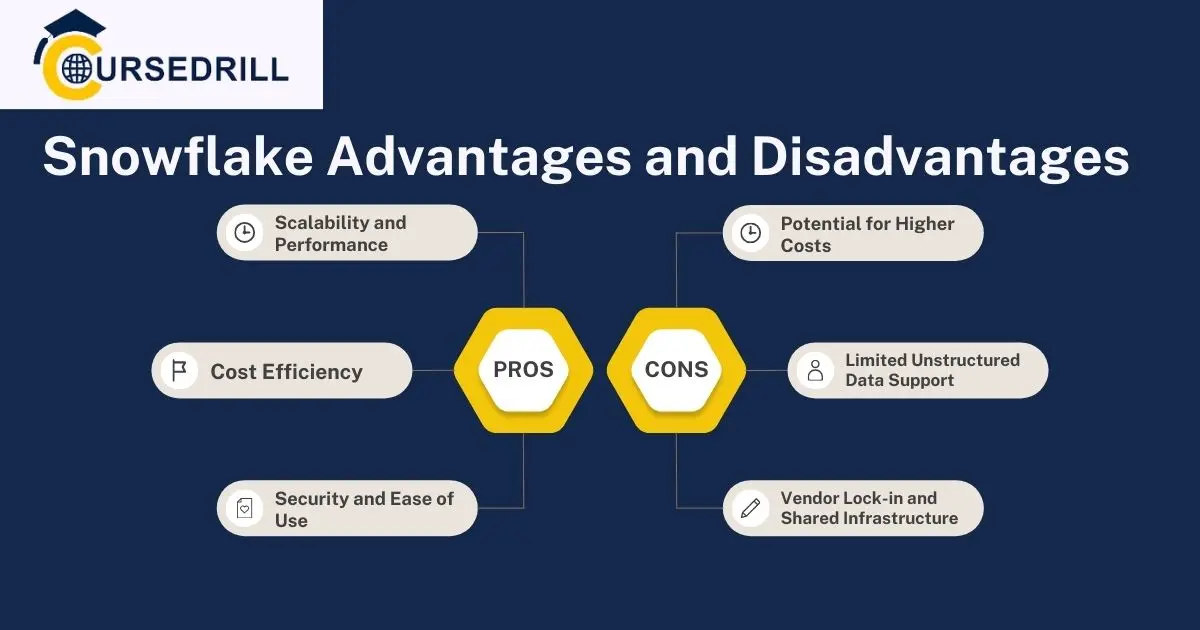- Posted on
- admin
- No Comments
What is Snowflake: Advantages and Disadvantages
Data warehousing has become an integral part of today’s data-driven business world. Earlier it was a challenging task to set up a data warehouse platform as it was associated with complex and expensive hardware and software requirements. Moreover, traditional data warehouse systems are required to run on specially designed hardware in the data centre. Snowflake has been revolutionizing the data warehousing industry with its ease of usage, unique architecture, advanced features, pricing model and a lot more.
In this blog, we are going to discuss what exactly the Snowflake software is, its advantages and disadvantages. Let’s get into the details part:
Following are the concepts covered in Snowflake Advantages & Disadvantages Tutorial:
Table of Contents
What is a Snowflake data warehouse?
Snowflake is an advanced, serverless, enterprise-ready data warehouse platform natively built for the cloud. It comes with a unique architecture specially designed for the cloud and offers a wide range of features to meet the modern data warehouse needs of organizations.
Snowflake demands no expensive hardware or software to select, install and manage.
The unique thing about Snowflake architecture is that it supports independent scalability of storage and compute. This would allow the customers to pay only for the resources they use and follows a pay as you go, model. Advanced data sharing capabilities allow enterprises in sharing data quickly and in a secure environment.
Interested to begin your career in a top Cloud Data warehouse platform?
Know more about the industry-oriented Snowflake training course. Talk to our subject matter experts!
Top Advantages of Snowflake Data Warehouse Platform
Snowflake comes with excellent features and unique architecture to suit modern business requirements. Its advanced capabilities in managing huge volumes of data helping businesses in reaping many advantages. Following are the typical advantages that an organization gains from using Snowflake.
1) Ease of Implementation
Snowflake is offered as a software as a service (SaaS) which can be quickly implemented without affecting your day to day business operations. Its implementation does not require any expensive software or hardware configuration. Snowflake brings all your data into one system and simplifies the process for analysis.
2) Cloud-First Approach
Snowflake data warehouse platform has been designed to harness the power of cloud computing technology. It simplifies the process to store and analyze data using cloud-based software and hardware. Snowflakes cloud-oriented design supports multi-cloud systems and cross-cloud applications. This popular tool can be deployed on top cloud providers like Amazon, Microsoft and Google.
3) Performance
Snowflake provides high performance compared to traditional data warehouse platforms. Its advanced architecture allows the users to run huge volumes of queries and allows users to easily scale up and down based on the requirements. The Infinite scalability feature allows its users to manage all workloads independently without affecting systems overall performance.
4) Low-cost
Snowflake is a cost-effective data warehouse platform and its pricing model differentiates it from other vendors. The customers actually need to pay for the computer and storage they use. It allows the storage of unlimited amounts of data at an affordable rate. Snowflake provides a feature on and off computer resources, so the charges will be levied only for the actual usage.
To meet the budget requirements and usage of all types of customers, Snowflake offers multiple editions The billing for the compute resources is done per second basis with a minimum usage of 60 seconds.
5) Supports Multiple Data Structures
Unlike the traditional data warehouse platforms, snowflake supports both structured and semi-structured data. It allows users to combine all types of structured and unstructured data for analysis and load it into a database without demanding any transformations or conversions. Snowflake automatically optimizes the data storage and querying process.
6) Advanced Data Sharing Capabilities
Snowflake architecture supports advanced data sharing capabilities and streamlines the process to share data among its users. It also supports data sharing with external parties using reader accounts. The reader account can be created directly from the user interface.
7) Self-Managing
Snowflake is a fully managed cloud data warehouse platform that supports warehouse auto-scaling, data sharing, and big data workload operations. It uses bridge Data lake software which supports automatic data load on the Snowflake. Snowflake platform easily scales along with the new requirements and handles multiple operations on its own.
8) Access & Security
High availability is one of the essential benefits of the Snowflake data warehouse platform. It can be distributed across all the regions of the cloud provider. It has been designed in a way to deliver constant services and shows little impact even when there are component or network failovers. It also offers advanced security measures by using SOC2 type II and more extra standard features.
Disadvantages of Snowflake
Every product has its own advantages and shortcomings and the same is the case with Snowflake. Following are some of the disadvantages of Snowflake:
- Snowflake owns the deployment infrastructure which makes the organizations fully depend on it. It becomes a challenging task to take swift actions in times of emergency.
- Snowflake shared cloud layer is shared among a large number of customers which means if any security incident occurs the entire data will be exposed to all the customers.
- Works on very few cloud tools like AWS, Azure and Google cloud.
Watch Snowflake Training Demo
Closing Thoughts
Snowflake has eliminated all the challenges associated with the traditional warehouses and emerged as one of the widely used cloud data platforms. Its simplified interface, unique features and easy accessibility have made it the no1 tool in the Data warehousing segment. You can also check out our Snowflake Tutorial here to have a complete overview of Snowflake architecture and its working style. You can also check out various Snowflake interview questions and answers here. Happy reading!
Author Bio

Yamuna Karumuri is a content writer at CourseDrill. Her passion lies in writing articles on the IT platforms including Machine learning, Workday, Sailpoint, Data Science, Artificial Intelligence, Selenium, MSBI, and so on. You can connect with her via LinkedIn.
Popular Courses



